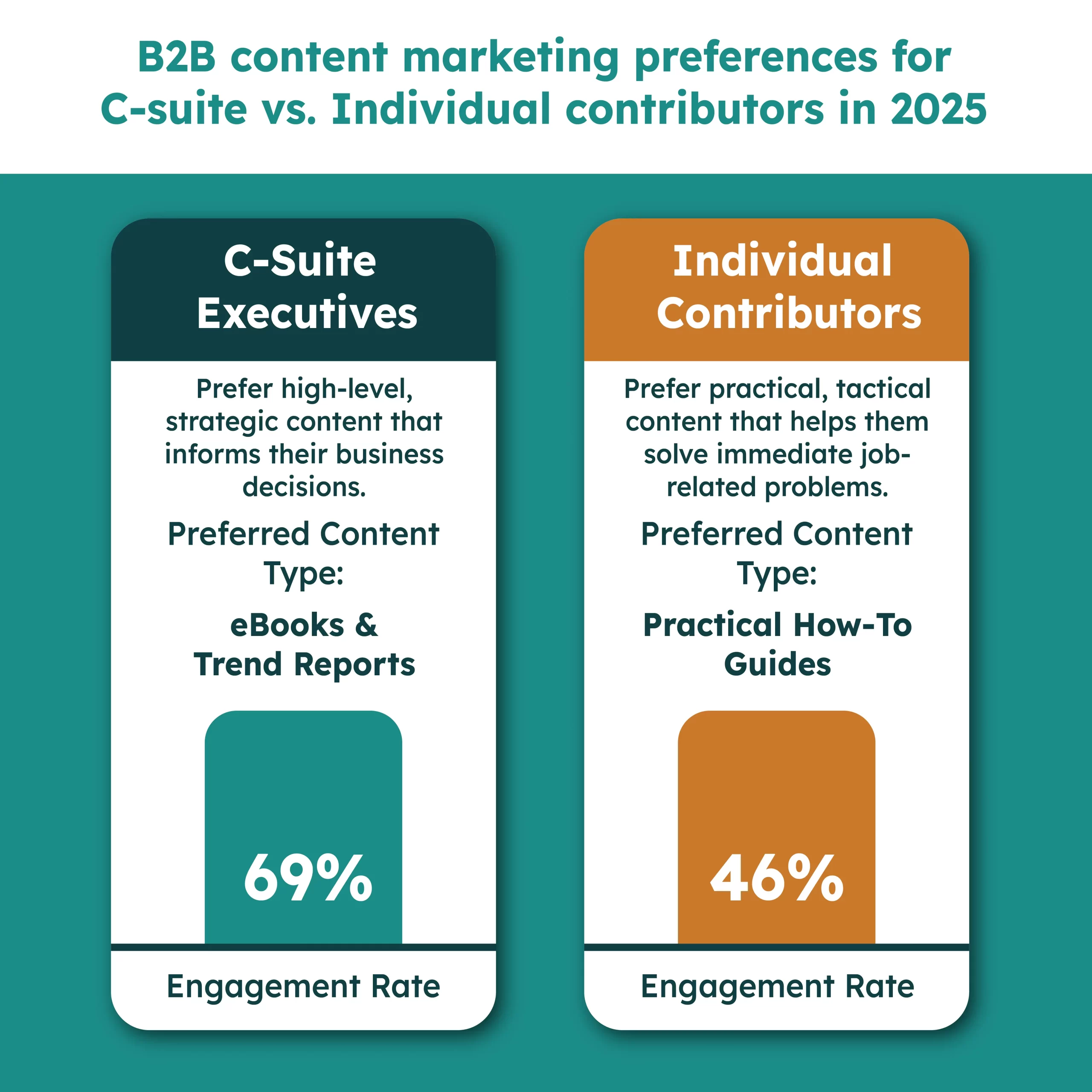I’ve been watching B2B marketing evolve for over a decade, and the last two years have been a complete game-changer. The old playbook of cold emails and gated content isn’t just outdated but irrelevant.
Here’s what I’ve learned: Buyers today do 80% of their research before they want to talk to us. They’re smarter, more skeptical, and tired of being sold to.
What works now? Building real relationships, sharing genuine insights, and focusing on the total B2B customer experience to help people do their jobs better.
Here Is The New B2B Buyer Journey Reality
They’re Doing Their Homework
A CMO told me something that stuck: “By the time I’m ready for a demo, I know more about your product than most of your sales reps do.” Ouch, but probably true.
Today’s buyers aren’t just independent, they’re allergic to traditional sales approaches. They want transparency, expect Netflix-level personalization, and can smell generic pitches from miles away.
The Cookie Apocalypse Hit Different in B2B
Third-party cookies are gone, which means old retargeting strategies for B2B can’t rely on sneaky tracking anymore. Everything we know about prospects needs to come from what they willingly share.
This shift has turned engagement from “nice-to-have” marketing into our primary data collection strategy. If we’re not providing enough value for voluntary engagement, we’re flying blind.
People Crave Real Human Connection
In our AI-everything world, being genuinely human has become a competitive advantage. Content showing real people, honest struggles, or admitting failures consistently outperforms polished corporate stuff.
Three Trends I’m Watching Closely
- Sales cycles are getting weird. Longer because more people are involved, but attention spans are shorter because everyone’s drowning in content.
- AI content fatigue is real. I can spot AI-generated content in the first paragraph, and so can your buyers.
- B2B is happening in unexpected places. My best engagement happens in Slack communities and Discord servers now, not just LinkedIn.

Core B2B Engagement Tactics That Drive Results
1. B2B Personalization Strategies That Don’t Feel Creepy
I’ve seen companies use AI to create websites that adapt in real-time, displaying different case studies to CTOs versus CFOs automatically. The key is staying helpful, not invasive. Nobody wants to feel stalked, but everyone appreciates relevant information. These are the kind of personalized B2B marketing examples that build trust, not suspicion.
2. The Heart of B2B Content Marketing: Helping People Do Their Jobs
Winners position themselves as the smartest voices in their space, focusing on what they know instead of what they sell.
Individual contributors love practical guides and engage with them 54% of the time. C-suite folks prefer strategic content like trend reports, engaging with eBooks at nearly 70%.
Interactive B2B content is gold. ROI calculators, assessments, and diagnostic quizzes are some of the best ways to boost B2B engagement through content because they are both engaging and useful. A cybersecurity company’s “security readiness assessment” became its top lead generator because it gave immediate, actionable insights.
3. Building Community: A Key to Omnichannel Marketing in B2B
Community is where magic happens. I’m talking about spaces where your audience connects with each other, not just you.
One SaaS company started a Slack community for CTOs. They barely promote their product, but when those CTOs need solutions, who do they call first? The company that facilitated valuable industry conversations.
4. Showing Up as Real People
Companies winning right now put employees front and center. CEO LinkedIn posts sharing real struggles, behind-the-scenes content, and customer stories told by customers themselves consistently outperform corporate content.
A logistics company posted an unscripted customer video about operational improvements. That video generated more qualified leads than their last three whitepapers combined.
What’s Actually Working Right Now: The Practical Stuff
Content That People Want to Interact With
Static content is losing. People want to participate in quizzes, assessments, and calculators that give personalized results based on input.
Content preferences vary wildly: Operations folks want implementable playbooks. Sales teams love templates. Product managers want practical guides and application-focused webinars.
LinkedIn Is Still King: Modern Social Media Strategies for B2B Engagement
Here’s a mistake: focusing energy on company pages instead of personal profiles. CEO posts with no product mention generate dozens of qualified leads just by sparking meaningful conversations.
Company pages are for credibility, personal profiles are for connection.
The Rise of Niche Communities
My best B2B conversations happen in industry-specific Slack channels, Discord communities, and subreddits. Show up as a helpful community member, not a vendor.
A fintech company joined a CFO-focused Discord and spent months being helpful. When those CFOs need financial tools, guess who they think of first?
Events That Don’t Suck
Generic webinars are dying. What works: intimate 15-person roundtables, VIP sessions, workshops where people work on real challenges.
Clip that 15-minute live Q&A into five social posts, a blog article, and a podcast episode. One event, multiple touchpoints.
Effective Email Marketing for B2B: Newsletters That Feel Like Letters
Newsletters I read feel like insights from someone I respect. They curate external content, share honest opinions, and highlight customer stories without being salesy.
Using Technology Without Losing the Human Touch
AI Done Right
The role of AI in B2B audience engagement is to enhance, not replace, human connection. AI is incredible for personalization through smart chatbots, behavior-triggered emails, and sensible content recommendations. But don’t automate everything.
The sweet spot: AI identifies opportunities, and real people follow up. AI spots high-intent prospects, and your SDR sends personal LinkedIn messages. These are the marketing automation tools B2B teams should embrace: tools that empower people, not sideline them.
Data-Driven B2B Engagement Tactics: Making Sense of the Data
Customer data platforms finally let us track meaningful customer engagement metrics across all touchpoints. Winners can tell you exactly which content pieces influence the pipeline and which are vanity metrics.
The Cool New Stuff
AR and VR make sense for complex B2B sales like virtual facility tours and immersive product demos. But cool technology only works if it solves real problems.
Measuring What Actually Matters
Focus on metrics aligned with how people buy:
- Early stage: Return visits, time on site, content consumption
- Middle stage: Downloads, email opens, webinar engagement
- Late stage: Demo requests, proposal responses, sales engagement
Individual contributor engagement rates hit 34%, while VPs average 26%. But VPs influence bigger deals, so you need different strategies for different audiences.
The Challenges Nobody Talks About
Trust Is Harder to Build Than Ever
People are skeptical of generic, unhelpful content. Solution: Be genuinely helpful before asking for anything. Detailed case studies with real numbers beat beautiful brochures.
Segmentation Can Paralyze You
Hyper-specific campaigns can cause paralysis. Instead of trying to segment everyone, a smarter account-based marketing (ABM) approach uses intent data to focus on accounts already in-market. This starts with knowing how to create B2B buyer personas for better community engagement with those key accounts.
Automation vs. Human Touch
Under-automate and you can’t scale. Over-automate and you sound robotic. Be strategic about where humans add irreplaceable value, like personalized videos and handwritten notes for big prospects.
Staying Flexible in a Fast-Changing Market
What worked six months ago might not work today. Thriving companies are comfortable with constant experimentation and quick pivots.
What’s Coming Next
AI assistants will handle discovery calls. Early versions already qualify prospects and schedule meetings, freeing humans for relationship building.
B2B influencer marketing is coming. Companies will partner with respected industry voices, like B2C brands, who use Instagram influencers. This is part of a broader shift in multi-channel engagement that B2B marketers must adapt to.
Everything will be more immersive. AR and VR will move from cool demos to standard practice for complex products.
Where to Start?
Pick one thing and do it well: start a weekly newsletter with genuine insights, launch a small Slack community, or commit to authentic CEO LinkedIn posts three times weekly.
Be consistent, measure results, and adjust based on real feedback from real people. Companies that figure out authentic, valuable engagement will dominate their markets. Those trying to automate their way out of building real relationships will struggle. The core principle is simple: be relentlessly helpful. That is how you will engage B2B customers and win in 2025.
Which one do you want to be?
